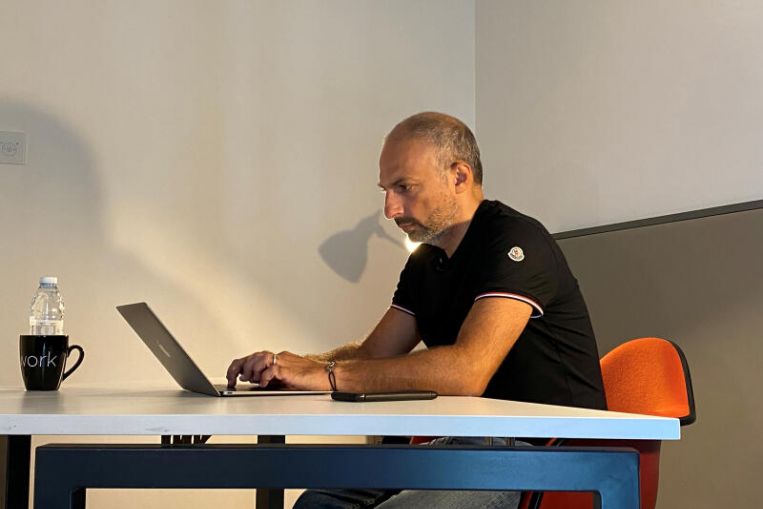LONDON (REUTERS) – Two weeks into the coronavirus lockdown and Mr Sergei Holmeckis, a boss at Deutsche Telekom's Czech operations in the city of Brno, was frustrated with staff video calls. His team did not like turning on their cameras and the discussion was stilted.
"I started to show them my cat," he said. "It showed the human side of me more and really changed the perception. It got people to switch on their cameras and be more engaged."
Such tactics obviously will not appeal to everyone. But they do show how the world's biggest experiment in working from home is forcing managers to reassess their methods – especially as surveys predict higher levels of remote working post-pandemic. Before the new coronavirus began spreading, just 2.9 per cent of the world's employees were working exclusively or mainly from home, according to the International Labour Organisation (ILO), a Geneva-based United Nations agency.
Within weeks, that figure exploded as social distancing forced companies to launch telework schemes. An Argentinian study found that 93 per cent of large firms had turned to telework; in Britain, half of all employers said that by late-April the bulk of their staff were working from home.
Surveys in the United States and Britain have shown over three-quarters of companies expect to offer more homeworking after the pandemic, with staff citing benefits such as greater work-life balance and claiming they felt just as productive as in the office.
Twitter was among the first to declare that working from home would be a permanent option, while the head of Barclays bank suggested that "putting 7,000 people in a building may be a thing of the past".
"This is a revolution here and we don't know what the end-result will be," said Mr Jon Messenger, an ILO expert on working conditions who has traced the history of telework since it first emerged in the mid-1970s with the label "telecommuting".
"Managers in the past have been very unwilling to do this because of the loss of direct control over subordinates… it requires a totally different approach to management."
Mr Messenger argues the new approach implies above all a shift towards greater results-based performance appraisal while allowing employees more scope to organise their work time.
But while various studies link so-called "time sovereignty" to productivity benefits, some companies find that hard to take on board. Developers of employee tracking software – which for example send managers screenshots of their staff's computer screens – are reporting a surge in sales. Companies where tasks are hard to quantify argue that some form of monitoring is essential.
But workplace experts warn that excessive surveillance can be counterproductive.
LONDON (REUTERS) – Two weeks into the coronavirus lockdown and Mr Sergei Holmeckis, a boss at Deutsche Telekom's Czech operations in the city of Brno, was frustrated with staff video calls. His team did not like turning on their cameras and the discussion was stilted.
"I started to show them my cat," he said. "It showed the human side of me more and really changed the perception. It got people to switch on their cameras and be more engaged."
Such tactics obviously will not appeal to everyone. But they do show how the world's biggest experiment in working from home is forcing managers to reassess their methods – especially as surveys predict higher levels of remote working post-pandemic. Before the new coronavirus began spreading, just 2.9 per cent of the world's employees were working exclusively or mainly from home, according to the International Labour Organisation (ILO), a Geneva-based United Nations agency.
Within weeks, that figure exploded as social distancing forced companies to launch telework schemes. An Argentinian study found that 93 per cent of large firms had turned to telework; in Britain, half of all employers said that by late-April the bulk of their staff were working from home.
Surveys in the United States and Britain have shown over three-quarters of companies expect to offer more homeworking after the pandemic, with staff citing benefits such as greater work-life balance and claiming they felt just as productive as in the office.
Twitter was among the first to declare that working from home would be a permanent option, while the head of Barclays bank suggested that "putting 7,000 people in a building may be a thing of the past".
"This is a revolution here and we don't know what the end-result will be," said Mr Jon Messenger, an ILO expert on working conditions who has traced the history of telework since it first emerged in the mid-1970s with the label "telecommuting".
"Managers in the past have been very unwilling to do this because of the loss of direct control over subordinates… it requires a totally different approach to management."
Mr Messenger argues the new approach implies above all a shift towards greater results-based performance appraisal while allowing employees more scope to organise their work time.
But while various studies link so-called "time sovereignty" to productivity benefits, some companies find that hard to take on board. Developers of employee tracking software – which for example send managers screenshots of their staff's computer screens – are reporting a surge in sales. Companies where tasks are hard to quantify argue that some form of monitoring is essential.
But workplace experts warn that excessive surveillance can be counterproductive.












